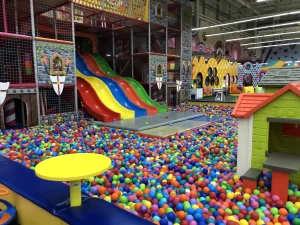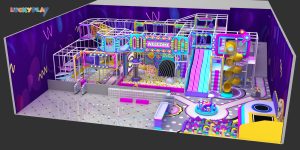Introduction
Play is not just about entertainment; it is a foundational aspect of early childhood development. Through play, children explore their environment, strengthen their muscles, develop cognitive skills, and build social bonds. In modern times, the increasing focus on safety and indoor recreation has given rise to specialized play environments and Soft Ball Playgrounds are at the forefront.
A soft ball playground is a specially designed area filled with lightweight, padded balls and surrounded by cushioned structures. It provides a secure and engaging space for children to jump, climb, explore, and interact without the risks associated with hard playground surfaces. These setups can be found in indoor play centers, daycares, preschools, therapy clinics, and even in private homes.
In this comprehensive guide, we’ll explore everything you need to know about soft ball playgrounds. Their structure, safety, benefits, educational value, maintenance, and even how they can become a business opportunity.
What is a Soft Ball Playground?
A soft ball playground, sometimes called a ball pit zone, is an enclosed area filled with thousands of soft, lightweight plastic or foam balls. These playgrounds are often enhanced with padded structures like tunnels, ramps, small slides, climbing steps, and interactive soft toys.
Unlike traditional playgrounds that may include wood, metal, or hard plastics, soft ball playgrounds are 100% cushioned and covered with non-toxic, child-safe materials. Everything is designed to be soft, colorful, and interactive, making them suitable even for infants and toddlers.
Common Settings for Soft Ball Playgrounds:
- Indoor play centers or soft play gyms
- Shopping malls play zones
- Pediatric therapy centers
- Preschool and daycare centers
- Fast food restaurant play areas
- Private residential playrooms
- Hotel kids’ zones or shopping mall lounges
Core Components of a Soft Ball Playground
- Ball Pits
The signature feature. These are shallow or deep pits filled with plastic or foam balls. Depending on the design, they may include:
- Mini ball pools for babies
- Large enclosed pits for group play
- Inflatable ball areas with airflow
- Soft Flooring
Padded EVA mats or vinyl flooring absorb shocks and prevent injury from slips or falls.
- Foam Structures
Children can climb on foam-made stairs, crawl through tunnels, or slide down mini chutes and they are all soft, durable, and safe.
- Barriers and Netting
Walls, nets, and padded dividers create enclosed zones to prevent balls from spilling and kids from wandering off.
- Interactive Elements
Some playgrounds feature games like soft ball basketball hoops, target walls, pop-up toys, or ball-shooting cannons for active play.
Benefits of Soft Ball Playgrounds
✅ Physical Growth
Soft ball playgrounds encourage active movement like crawling, climbing, jumping, throwing, and rolling. These actions help improve:
- Gross motor skills
- Hand-eye coordination
- Balance and stability
- Core strength
✅ Cognitive Development
Children learn:
- Cause and effect (throwing a ball and watching it bounce)
- Object permanence
- Shape and color recognition
- Problem-solving (navigating a maze or tunnel)
✅ Social and Emotional Growth
Playing with peers helps children:
- Take turns
- Share space
- Develop empathy
- Learn conflict resolution
Soft ball environments are also less intimidating, allowing shy or anxious children to feel safe and gradually open up.
✅ Sensory Integration
These playgrounds offer multi-sensory stimulation:
- Tactile (soft surfaces, varied textures)
- Visual (bright colors)
- Auditory (ball movements, soft clinks)
This is especially beneficial for children with sensory processing challenges, including those on the autism spectrum.
Age-Appropriate Zones
👶 Babies (6 months – 12 months)
- Soft, shallow ball pits with high visibility
- Padded mats for tummy time and crawling
- Colorful mirrors and sensory textures
🧒 Toddlers (1–3 years)
- Low slides and tunnels
- Ball pools with ramps
- Easy-to-grip foam blocks
🧒 Preschoolers (3–5 years)
- Climbing steps and multi-level soft frames
- Mini basketball hoops or ball shooters
- Imaginative play corners
👦 Young Kids (6–9 years)
- Larger ball arenas
- Group games (tag, throw-and-catch)
- Obstacle challenges or soft dodgeball games
🏠 Indoor vs. 🌳 Outdoor Soft Ball Playgrounds
Soft ball playgrounds can be enjoyed both indoors and outdoors, but the setting plays a major role in determining the play experience, safety, maintenance, and practicality. Let’s take a closer look at how indoor and outdoor setups compare, and which one might be better suited to different needs.
🏠 Indoor Soft Ball Playgrounds
Indoor soft ball playgrounds are the most common and widely used format—often found in commercial play centers, malls, schools, and private homes. They offer a controlled, hygienic, and weather-independent play environment.
✅ Advantages
- Climate-Controlled Environment
Indoor setups are shielded from external weather conditions. Rain, extreme heat, or cold won’t interfere with playtime. This ensures year-round usability, regardless of season. - Safety and Cleanliness
Indoors, the equipment and ball pit can be better protected from dirt, insects, or allergens like pollen. It’s much easier to keep the area clean, sanitize the balls, and ensure a hygienic environment most especially important in child care centers or hospitals. - Long-Term Durability
Soft ball playground structures used indoors are typically built with higher-quality, more permanent materials like molded plastic, soft foam, and padded vinyl, which last longer and are less exposed to wear and tear. - Consistent Lighting and Visibility
Proper lighting inside allows parents and caregivers to always keep a better watch on children, reducing the risk of unseen accidents or hiding. - Integrated Learning Spaces
Many indoor play zones also include educational features like puzzles, sensory panels, or themed zones, turning soft play into a holistic developmental experience.
⚠️ Limitations
- Space Restrictions: Indoor setups may be limited by room size or ceiling height.
- Costly Setup: Permanent indoor playgrounds can require significant investment in materials, padding, and child-safe design.
🌿 Outdoor Soft Ball Playgrounds
Outdoor soft ball play zones are typically temporary, inflatable, or event-based installations. They’re often used during:
- Birthday parties
- Carnivals and fairs
- Community festivals
- School field days
✅ Advantages
- Spacious and Open
Outdoor environments allow for larger play zones, accommodating more children and more expansive activities. - Natural Light and Air
Kids benefit from sunshine and fresh air while engaging in physical activity, supporting physical health and mood regulation. - Ideal for Events and Group Play
These playgrounds add color and excitement to outdoor gatherings. They’re portable, easy to set up for a day, and offer novelty that excites children. - More Active Play
Since they often include obstacle courses or inflatable ball zones, outdoor setups encourage running, jumping, and group games on a larger scale.
⚠️ Limitations
- Weather Dependent
Outdoor ball pits are vulnerable to:- Sudden rain showers
- Wind gusts
- Excessive heat or UV exposure
This makes them unpredictable and not suitable for long-term use.
- Cleaning Challenges
Keeping outdoor soft balls clean is significantly harder. Dirt, leaves, bugs, and even animal droppings can contaminate the area quickly. This increases the need for frequent cleaning and sanitization. - Shorter Lifespan
Most outdoor soft play setups are inflatable and not designed for daily long-term use. Exposure to sun, moisture, and rough surfaces accelerates material breakdown. - Additional Safety Measures Required
To ensure comfort and safety, outdoor ball pits often require:- Foam floor mats or grass coverings underneath
- Shade canopies to prevent sunburn
- Weighted or secured sides to prevent tipping or collapsing
📊 Indoor vs. Outdoor: A Quick Comparison Table
| Feature | Indoor Soft Ball Playground | Outdoor Soft Ball Playground |
| Weather Protection | ✅ Fully protected | ❌ Weather-dependent |
| Hygiene & Cleanliness | ✅ Easier to sanitize | ❌ Prone to dirt and outdoor elements |
| Year-Round Use | ✅ Yes | ❌ Seasonal or temporary |
| Material Durability | ✅ Permanent-grade materials | ❌ Inflatable or disposable |
| Space Availability | ❌ Limited to room size | ✅ More open, flexible space |
| Event Suitability | ❌ Not portable | ✅ Ideal for parties and festivals |
| Maintenance Cost | ✅ Lower long-term | ❌ Higher due to wear and tear |
| Setup Time | ❌ Requires permanent installation | ✅ Quick to inflate and deflate |
| Learning Integration | ✅ Often includes educational tools | ❌ Purely recreational |
Safety Features and Material Standards
A high-quality soft ball playground should follow strict safety guidelines:
✅ Non-Toxic Materials
- BPA-free, lead-free, and phthalate-free balls and padding
- Certified food-grade plastics
✅ Flame Retardant Foams
- Meets ASTM and EN safety standards
✅ Antibacterial Surfaces
- Vinyls treated with antimicrobial coatings
✅ Rounded Edges
- No sharp corners or hard surfaces
✅ Secure Netting and Barriers
- Prevents children from leaving the area or falling out
✅ Proper Depth
- Ball pits should be shallow for babies and deeper for older children to ensure safety.
Developmental Benefits in Therapy and Education
Occupational therapists and special education professionals often integrate soft ball environments into:
- Sensory Integration Therapy
- Gross motor delay interventions
- Social learning programs
- ADHD focus-building tasks
Benefits for Neurodivergent Children:
- Safe place to self-regulate
- Deep pressure from weighted or dense foam balls
- Quiet corners reduce overstimulation
Soft Ball Playgrounds as a Business Venture
Many entrepreneurs are turning soft ball playgrounds into profitable ventures by opening indoor play cafes, soft play gyms, or event rental services.
Business Models:
- Play Centers: Pay-per-hour indoor facilities
- Mobile Soft Play Rentals: Deliver, set up, and pack away at birthday events
- Soft Play Cafes: Play while parents enjoy food and coffee
- Soft Ball Corners in Retail Spaces: Drive family foot traffic
Revenue Streams:
- Admission fees
- Monthly memberships
- Party/event bookings
- Merchandising or snacks
- Workshops and parent-toddler classes
Maintenance and Sanitation
Keeping the play environment clean is critical especially with ball pits that are shared by multiple children.
Daily Tasks:
- Remove visible debris
- Wipe high-touch surfaces with disinfectant
- Vacuum the flooring
Weekly:
- Sanitize foam structures
- Deep clean mats and padding
- Rotate and wash balls using ball-cleaning machines or soapy rinses
Monthly:
- Perform mold inspections
- Refill any worn-out balls
- Check seams for wear-and-tear
Soft ball playgrounds with proper sanitation routines have fewer illness transmission risks and maintain customer trust.
Creative Design Themes
Creating a themed environment enhances the play experience:
Popular Themes:
- Under the Sea: Blue ball pits, fish-shaped foam blocks
- Jungle Safari: Leaf-shaped mats, animal sound buttons
- Space Mission: Rocket tunnels, silver and black balls
- Candyland: Pastel balls, cupcake-shaped climbers
Aesthetic Options:
- Minimalist Scandinavian (neutral tones, soft lighting)
- High-Contrast Zones for visual stimulation
- Eco-Themed Centers using recycled foam and sustainable packaging
Future Innovations in Soft Ball Playgrounds
Playground design is evolving quickly, and soft ball areas are no exception.
🔮 Smart Play Features
- Balls that light up or make sounds when moved
- Touch-sensitive panels or pressure-activated games
- Integration with apps for educational games
🌿 Eco-Friendly Upgrades
- Biodegradable balls
- Recyclable foam padding
- Solar-powered lighting in commercial setups
🧠 Sensory Technology
- Color-changing LEDs
- Scent diffusers for calming or energizing effects
- Soundscapes that respond to motion
🏗️ Modular Systems
- Portable ball zones that click together
- Build-your-own kits for homes or classrooms
Tips for Setting Up a Soft Ball Playground at Home
Creating a home-friendly version is easier than you think.
Essentials:
- Pop-up or foldable ball pit
- Set of 300–500 BPA-free balls
- Soft foam tiles or mats
- Padded wall bumpers (if indoors)
Optional Add-ons:
- Small slide leading into pit
- Foam tunnels or building blocks
- LED balls or sensory features
Make sure the area is clean, enclosed, and always supervised. Ideal places include nurseries, playrooms, or shaded patios.
Conclusion: Colorful Havens for Safe and Enriching Play
Soft ball playgrounds deliver far more than just playful excitement and they serve as secure, developmentally enriching, and sensory-friendly spaces for children of all ages and abilities. In a world where safety, inclusive play, and sensory engagement are increasingly prioritized, these playgrounds shine as versatile environments that align with modern parenting and educational values.
Whether you’re a parent searching for a safe and joyful activity, a school aiming to upgrade its play facilities, or an entrepreneur entering the children’s recreation market, investing in a soft ball playground is an investment in children’s happiness, growth, and well-being.
🌟 Final Thought
Whether you’re a parent seeking a safe and joyful play option at home, a school or daycare upgrading its facilities, or an entrepreneur entering the children’s recreational market, a soft ball playground is more than a colorful play zone and it’s an investment in healthier, happier childhoods.
In a world where kids need to move more, laugh more, and connect more, these vibrant spaces are a soft, bouncing answer to many of today’s parenting and educational needs. At the heart of every soft ball playground is a promise: a safe space to play, grow, and simply be a child.




